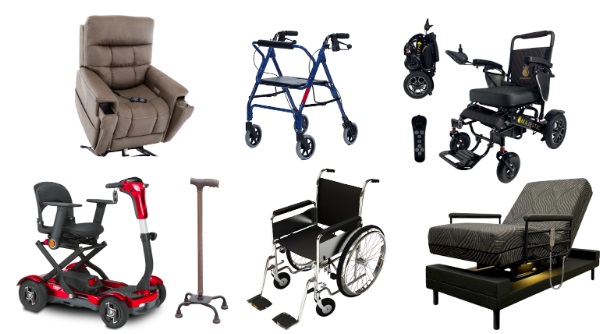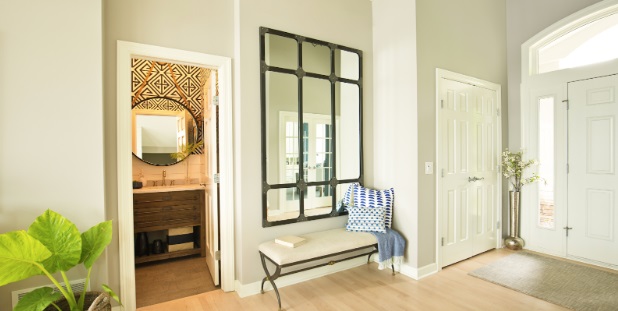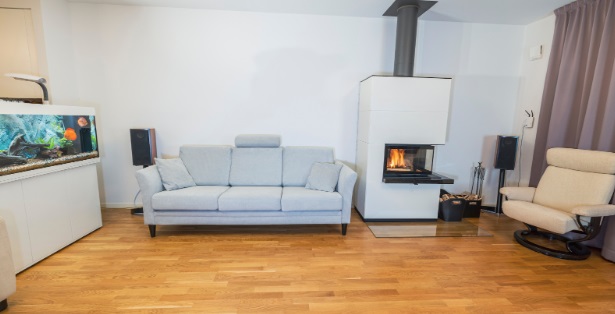Asset Publisher
Practical Tips for Aging in Place with Mobility Aids
03/07/2024

An older couple researching mobility aids on their smart device.
The Concept of Aging in Place
Aging in place is the ability to live in one's own home and community safely, independently, and comfortably, regardless of age, income, or ability level. This concept is becoming increasingly popular as individuals seek to maintain their independence and familiar surroundings as they grow older.
Aging in place is about:
- Maintaining independence: Staying in a familiar environment.
- Comfort: Keeping personal possessions and memories close.
- Safety: Adapting the home to meet the changing physical needs.
The goal of Aging in Place is to empower older adults to live in their own homes for as long as possible, with a high quality of life.
Financial considerations, health status and social connections are critical factors that influence the feasibility of aging in place. Planning ahead and making the necessary adjustments can help ensure that the home environment remains a safe and supportive space for older adults.
Challenges to Aging in Place
Aging in place can be a complex process, with various obstacles that may arise as one's mobility and health needs change. One of the primary challenges is ensuring the home environment continues to be safe and accessible. Many homes are not originally designed with the needs of older adults in mind, leading to potential hazards, such as:
- Lack of Accessibility: Navigating a home with stairs or narrow doorways can become difficult.
- Limited Mobility: The need for mobility aids can complicate movement in tight spaces.
- Poor Safety: Increased risk of falls due to slippery surfaces or inadequate lighting.
It is essential to recognize these challenges early and plan for home modifications that can mitigate risks and enhance the quality of life for older adults.
Financial constraints can also pose a significant barrier to making necessary home modifications. The cost of installing ramps, stairlifts, or walk-in tubs can be prohibitive without financial assistance or planning. Additionally, the emotional impact of altering a long-time residence can be considerable, requiring sensitivity and support from family and community.
Mobility Aids for Older Adults

Types of Mobility Aids
Mobility aids are crucial tools that help older adults maintain their independence and navigate their living spaces safely. Different aids are designed to address varying levels of mobility challenges:
- Canes provide balance support for those who have slight mobility impairments.
- Walkers offer more stability than canes and are ideal for individuals who need additional support.
- Wheelchairs are suited for those who require seated mobility assistance.
- Scooters are electric mobility aids for those who can travel longer distances without fatigue.
- Stairlifts and platform lifts help overcome barriers posed by stairs, allowing access to different levels of the home.
It's important to assess the older adult’s specific needs and living environment when selecting a mobility aid, as the right choice can significantly enhance their quality of life.
Each type of mobility aid comes with its own set of features and considerations. For instance, canes and walkers are relatively low-cost and easy to maneuver, while wheelchairs and scooters may require more significant financial investment and space for operation. Stairlifts, while highly effective, need professional installation and maintenance. Understanding these factors is key to making an informed decision that ensures safety and mobility for those aging in place.
Restore Mobility steps in to simplify this decision-making process by offering a comprehensive range of mobility products tailored to the specific needs of older adults. Their expertise in the field allows them to provide valuable advice on selecting the right mobility aids, considering both the immediate benefits and the long-term requirements for maintenance and adaptability, ensuring each individual can maintain their independence and quality of life.
Choosing the Right Mobility Aid
Selecting the appropriate mobility aid is crucial for maintaining independence and safety. The choice should be based on the individual's specific mobility challenges and lifestyle needs. It's important to consult with healthcare professionals to determine which aid will offer the best support.
Here are some factors to consider when choosing a mobility aid:
- The level of support needed
- The user's balance and coordination
- The environment in which the aid will be used
- The user's physical strength and endurance
When evaluating mobility aids, consider not only the immediate benefits but also how the aid will adapt to changing mobility needs over time.
For example, someone with mild balance issues might benefit from walking poles, while another individual with more significant challenges might require a power scooter. Below is a list of common mobility aids:
- Walking Poles or Walking Sticks
- Canes
- Crutches
- Walkers and Rollators
- Power Scooters
- Manual Wheelchairs
Each option offers different levels of support and mobility, and the right choice will depend on the user's unique situation.
Essential Home Modifications for Aging in Place

Making Entrances and Exits Accessible
Ensuring that entrances and exits are accessible is a fundamental step in adapting a home for aging in place. The entrance and exits are the primary areas to address, as they are the main points of transition between the home and the outside world. Installing ramps in place of stairs can greatly enhance accessibility for those who use wheelchairs or walkers.
- Add sturdy handrails on both sides of the walkway for support.
- Ensure that all walkways are well-lit to prevent falls during the night.
- Consider the installation of non-slip flooring materials to reduce the risk of slips and trips.
Making these modifications not only increases safety but also promotes independence for older adults as they navigate in and out of their homes.
It's important to assess the specific needs of the individual when planning these modifications. For instance, the width of ramps should accommodate the mobility aid in use, and the slope must be gentle enough to allow for easy passage without excessive exertion.
Bathroom Safety Adjustments
Ensuring bathroom safety is a critical aspect of aging in place. Slips and falls in the bathroom can be particularly dangerous, but they are preventable with the right modifications. Firstly, use non-slip textured strips or mats on the tub or shower floor to increase traction and minimize slips. A simple modification such as a curved pole can provide additional support and stability.
When considering bathroom safety, it's important to focus on accessibility and ease of use. This includes installing grab bars in strategic locations such as near the toilet and in the shower area.
Other potential adjustments include:
- A raised toilet seat to reduce the effort needed to sit down and stand up.
- A walk-in bathtub or a shower with a bench to make bathing safer and more comfortable.
- Lever faucets that are easier to use for those with limited hand strength or dexterity.
Stair and Hallway Modifications
Stair and hallway modifications are crucial for ensuring safe navigation throughout the home. Installing handrails on both sides of staircases can provide the necessary support for older adults as they ascend and descend. It's also important to consider the width of hallways; they should be spacious enough to accommodate mobility aids without obstruction.
- Ensure adequate lighting to prevent trips and falls.
- Remove any loose carpets or rugs that could pose a trip hazard.
- Consider stair lifts for those who cannot manage stairs independently.
Making these changes not only enhances safety but also promotes independence within the home environment.
For older adults with significant mobility challenges, stair lifts can be a game-changer. They allow for easy access to different levels of the home without the physical strain of climbing stairs. When selecting a stair lift, it's essential to consider the specific needs of the individual, such as the type of staircase, the user's weight and any additional features that may be required for comfort and safety.
Creating a Age-Friendly Living Space

Minimizing Hazards Throughout the Home
Ensuring a safe living environment is crucial for older adults choosing to age in place. Regular assessment and modification of the home can significantly reduce the risk of falls and injuries. It's important to create clear pathways and remove tripping hazards such as loose rugs, electrical cords, and clutter. Remember to:
- Keep floors clear and non-slip.
- Install grab bars and handrails where necessary.
- Ensure adequate lighting, especially in stairways and hallways.
- Arrange furniture to allow easy movement around the house.
By proactively addressing potential hazards, older adults can maintain their independence and continue to live comfortably in their own homes. This approach not only enhances safety but also promotes a sense of well-being and confidence.
Remember, the goal is to help prevent injuries and maximize independence for a loved one aging at home. Regularly reviewing the living space for safety and making necessary adjustments is a key part of safe home care.
Smart Home Technologies for Older Adults
In the digital age, smart home technologies offer older adults unprecedented convenience and safety, enhancing their ability to age in place. These technologies can be controlled remotely and can be programmed to suit individual needs, making daily tasks simpler and safer.
- Voice-activated assistants can help with tasks like making phone calls, sending messages, or controlling other smart devices.
- Automated lighting can prevent falls by providing well-lit spaces without the need to reach for switches.
- Smart thermostats allow for easy temperature control, ensuring comfort without the physical strain of manual adjustments.
- Security cameras and smart locks enhance safety by allowing older adults to monitor their homes and control access remotely.
Embracing smart home technology can significantly reduce the risks associated with living alone, providing peace of mind for both older adults and their loved ones.
While these technologies can be incredibly beneficial, it's important to choose user-friendly devices and to provide proper training on their use. This ensures that loved ones can fully utilize the features and support that smart home devices offer.
Supporting Aging in Place with Caregiver Assistance
The Role of Caregivers in Aging in Place
Caregivers play a pivotal role in enabling older adults to age comfortably and safely in their own homes. Their presence can significantly reduce the risks associated with living alone, such as falls, medication mismanagement and social isolation. Caregivers may be family members, friends or professional aides, each bringing different levels of support and expertise:
- Family caregivers often provide emotional support and assist with daily activities.
- Professional caregivers can offer more specialized care, including medical and therapeutic services.
- Friends and community volunteers might help with transportation, shopping or companionship.
It is essential to establish a support system that addresses the unique needs of the older adult. This may involve coordinating schedules, setting up emergency response systems and ensuring regular communication between all parties involved.
The responsibilities of caregivers are vast and often go unnoticed. They are the unsung heroes who make aging in place a viable option for many. Recognizing and supporting their efforts is crucial for the sustainability of this approach.
Incorporating Home Care Services
Incorporating home care services is a vital component of aging in place, providing older adults with the necessary support to maintain their independence. Professional caregivers can offer assistance with daily activities, ensuring that the loved one can navigate their day-to-day lives safely and comfortably. These daily activities can include:
- Personal care, such as bathing and dressing
- Medication management
- Meal preparation and nutrition
- Light housekeeping
- Companionship and emotional support
The integration of home care services not only enhances the quality of life for older adults but also offers peace of mind to family members, knowing that their loved ones are in capable hands.
It's important to tailor home care services to the older adult’s individual needs. A thorough assessment by a healthcare professional can help determine the level of care required. As needs change over time, services can be adjusted accordingly to ensure that older adults continue to receive the appropriate level of support.
Financial and Community Resources for Aging in Place
Funding Home Modifications and Mobility Aids
Securing funds for home modifications and mobility aids is a critical step in the process of aging in place. Many older adults may not have the financial resources to cover the costs of necessary changes to their homes. However, there are various options available to help alleviate this financial burden.
- Home modification grants can provide significant assistance. These grants are designed to cover a wide range of accessible modifications, which may include the installation of wheelchair ramps, the lowering of kitchen cabinets and other necessary adjustments to make a home more accessible.
- Low-interest loans are another avenue to explore. These loans can be used to finance larger projects that grants may not fully cover.
- Insurance policies, including long-term care insurance, may also contribute to covering costs, depending on the policy details.
It's important to thoroughly research and understand the different funding sources available, as they can vary greatly in terms of eligibility and the scope of what they cover.
Lastly, local community organizations and charities often have programs or funds set aside to assist older adults with home modifications. Reaching out to these groups can provide additional support and resources.
Leveraging Community Support and Resources
Aging in place successfully often requires more than just home modifications and personal adjustments; it also involves tapping into the community support and resources available. Many communities offer a variety of services designed to assist older adults in maintaining their independence and quality of life:
- Senior centers often provide social activities, meals, and educational programs.
- Transportation services can help those who no longer drive stay mobile and connected.
- Home-based services offer assistance with daily tasks and health care needs.
- Volunteers may provide companionship and help with errands or minor home repairs.
It's essential to explore local resources and understand how they can complement personal efforts to age in place. By doing so, older adults can create a supportive network that fosters independence and well-being.
Financial assistance programs may also be available to help cover the costs of services and modifications. It's important to research and apply for any grants, subsidies, or programs that can alleviate the financial burden of aging in place.
In conclusion, aging in place with the support of mobility aids requires a holistic approach that encompasses understanding the challenges, selecting the right aids, making essential home modifications, creating a age-friendly living space, and utilizing caregiver assistance along with financial and community resources. By implementing these practical tips, older adults can maintain their independence and quality of life in the comfort of their own homes.
Related Assets
Suggested Reads
Aging in Place: When is the Right Time to Right Size?
Deciding whether to continue to live in the home we have lived in for decades is a difficult decision. Not only are there financial considerations to think about, but we also need to factor in health and safety issues, such as whether our home can be easily na...
Bathroom Safety for a Loved One with Late Stage Dementia
These days, about 80 percent of people with Alzheimer’s disease and related dementias (ADRD) stay in their own homes with the support of family and friend caregivers rather than move to long-term care facilities. While aging in place can provide a loved one wi...
There's No Place Like Home: Creating Safe Environments for People With Late Stage Dementia
For someone with Alzheimer’s or another memory disorder, home may not always be the safest or most convenient place to live. As caregivers, we can help a loved one make modifications so they can continue to live safely in familiar surroundings.
Homebuyer Education
Our FREE HUD-approved homebuyer education class can teach you the important basics of the home buying process. We will provide you with the knowledge you’ll need to secure an affordable mortgage and buy the right house for you.
Read More